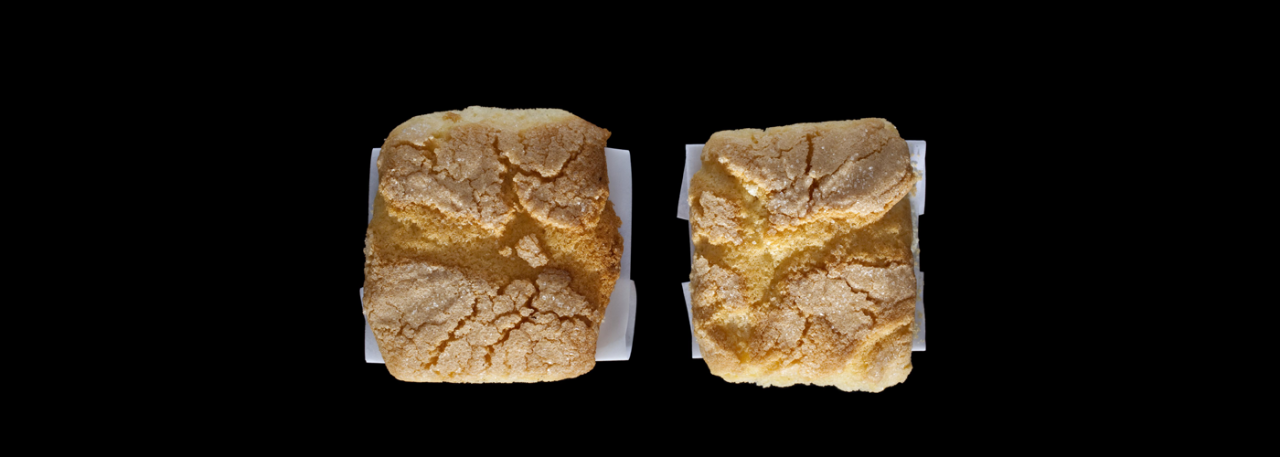.png.transform/rendition-xs/image_image%20(1).png)
Mantecadas de Astorga PGI
Cakes made by baking a beaten mixture of weak wheat flour, eggs, butter, lard and sugar.
Tasting notes
Very sweet, with the taste and aroma of butter and eggs predominating. When you bit it, the sugar on the surface is crunchy.The fat content ensures that the product is moist and spongy. The crumb is smooth on the palate and the crust is firm, golden and curved, with sugar grains at the center.
Other notes
The cakes are yellow from the butter and egg used to make them. Physical and chemical characteristics:
- Moisture: 15% minimum and 19% maximum
- Protein: 6% minimum
- Fat: 20% minimum and 27% maximum
- Carbohydrates (glucose): 45% minimum
- Ash: 1.70 % maximum
- Water activity (aw): 0.8 minimum and 0.9 maximum
- Texture (according to Texture Expert Program): 1,000 g minimum and 1,600 g maximum
The Mantecadas are baked and sold in individual kraft-type paper cases shaped to form square, open boxes. The dough rises in height by approximately 1.5 cm (0.6") above the top of the case in a rounded shape, never pointed, and should overlap the top edges and may even drip forming a toasted but never burnt overlap. The base of the case should be slightly brown but not burnt. Each cake, with its case, weighs between 25 and 30 g (1 oz). The cake inside is soft and spongy, with many small air holes, uniformly distributed throughout.
Mantecadas made from 1 October to 31 March last for 60 days, and those made from 1 April to 30 September for 45 days.
Production / Processing method
Proportions and characteristics of the basic ingredients of the dough:
- Weak wheat flour: 28 to 31%
- Fat: 21 to 25%. The only fats permitted are butter and lard, with lard accounting for no more then 20% of total fats.
- Egg: 21 to 25%. They must be hen’s eggs and either fresh or pasteurized.
- Sugar: 17 to 23%. Sucrose in the form of granulated sugar.
The following operations are involved in making the Mantecadas:
First, the fats are beaten until smooth and creamy. (It is not necessary for the fat to be warm). The eggs are then beaten at maximum speed together with the sugar (or authorized sweetener) for five to ten minutes until the mixture has approximately tripled in size. The flour is then gently folded into the egg mixture using the beater at slow or medium-slow speed. Finally, the fats are added and mixed in for 1½-4 minutes. The mixture is then transferred to the dosing machine and poured into the cake cases. A little granulated sugar is sprinkled uniformly over the center of each cake. The cakes are baked at temperatures between 190ºC (374ºF) and 280ºC (536ºF) for 14-15 minutes in convection ovens and for 17-20 minutes in fan ovens. After being removed from the oven, they must be cooled for at least one hour.
Geography / Relief and climate
The territory of Castile-León is very complex but can be broadly defined as having three main areas – the chain of mountains, peneplains in the west and the sedimentary basin. The region’s ecology is very varied. The highest peaks are in the Cantabrian mountains. Astorga is in the province of León. Brazuelo lies to the west of the province of León and belongs to Maragatería district. San Justo de la Vega is located 4 km from Astorga, on the banks of the river Tuerto, in the La Vega district, and Valderrey is in the province of León.
Spring is short, summer is short and hot, autumn is long and pleasant and winter is long, hard and very cold, with heavy snowfalls in the mountainous parts. In general, the climate is harsh (continental Mediterranean) with extreme temperatures. Maxima reach 37ºC (98ºF) in July, and minima -17ºC (1ºF) in January.
Regulatory Council
Consejo Regulador de la IGP Mantecadas de Astorga
C/ Padres Redentoristas, 26
24700 Astorga (León)
Tel: (+34) 987 616 336
info@mantecadasdeastorga.es
www.mantecadasdeastorga.es
Sources:
- Spanish Ministry of Agriculture
The cake inside is soft and spongy, with many small air holes.


- Muffin 1
- Muffin 2

Astorga (Castile-Leon)
